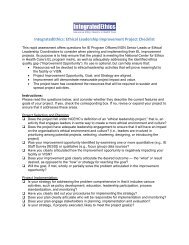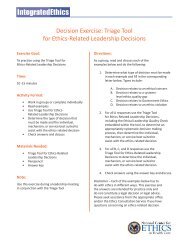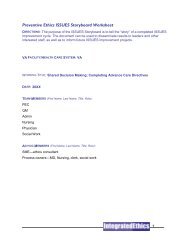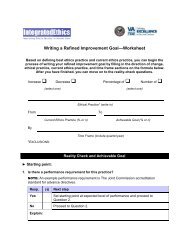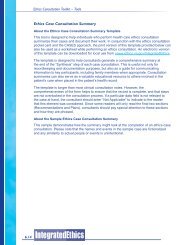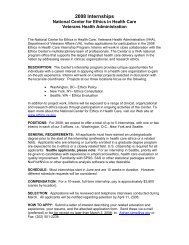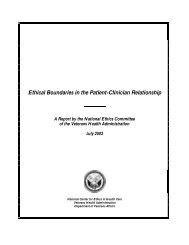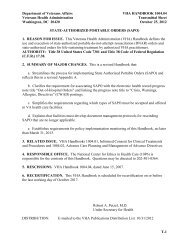Ethical Leadership: Fostering an Ethical Environment & Culture ...
Ethical Leadership: Fostering an Ethical Environment & Culture ...
Ethical Leadership: Fostering an Ethical Environment & Culture ...
You also want an ePaper? Increase the reach of your titles
YUMPU automatically turns print PDFs into web optimized ePapers that Google loves.
Part II: Introduction to <strong>Ethical</strong> <strong>Leadership</strong>How Do Leaders Affect Their Org<strong>an</strong>ization’s <strong>Ethical</strong><strong>Environment</strong> <strong>an</strong>d <strong>Culture</strong>?The task of ethics m<strong>an</strong>agement is to define <strong>an</strong>d givelife to <strong>an</strong> org<strong>an</strong>ization’s guiding values, to create <strong>an</strong>environment that supports ethically sound behavior,<strong>an</strong>d to instill a sense of shared accountability amongemployees.[25]Leaders’ behavior—including everything a leader says <strong>an</strong>d does—c<strong>an</strong> affect theenvironment <strong>an</strong>d culture of their org<strong>an</strong>ization in obvious or subtle ways. The “primaryembedding mech<strong>an</strong>isms” through which leaders’ words <strong>an</strong>d actions shape org<strong>an</strong>izationalculture are:[61]• what leaders pay attention to, measure, <strong>an</strong>d control on a regular basis• how leaders react to critical incidents <strong>an</strong>d org<strong>an</strong>izational crises• observed criteria by which leaders allocate scarce resources• deliberate role modeling, teaching, <strong>an</strong>d coaching• observed criteria by which leaders allocate rewards <strong>an</strong>d status• observed criteria by which leaders recruit, select, promote, retire, <strong>an</strong>d ostracizeorg<strong>an</strong>izational membersThe message leaders send through these primary mech<strong>an</strong>isms are reinforced through suchadditional me<strong>an</strong>s as org<strong>an</strong>ization design <strong>an</strong>d structure, systems <strong>an</strong>d procedures, the designof physical space, <strong>an</strong>d the org<strong>an</strong>ization’s rituals, stories, legends, <strong>an</strong>d myths about people<strong>an</strong>d events.[61]The influence of leadership behavior on the ethical environment <strong>an</strong>d culture of org<strong>an</strong>izationsis well documented. Whether that influence is deliberate or unintentional, it is powerful.Employees tend to adjust their own ethical orientations to the behavior they observe amongleaders in their org<strong>an</strong>ization. Research has shown, in fact, that—astonishingly!—“mostleaders are signific<strong>an</strong>tly more likely to lower their subordinates’ ethical st<strong>an</strong>dards th<strong>an</strong> toelevate them.”[62] To counteract this tendency, leaders must take proactive steps to foster<strong>an</strong> ethical environment <strong>an</strong>d culture.<strong>Fostering</strong> <strong>an</strong> ethical environment <strong>an</strong>d cultureResearch has shown that leaders play a critical role in creating, sustaining, or ch<strong>an</strong>ging allaspects of org<strong>an</strong>izational culture, including ethical culture. For example, one survey foundthat:Where employees perceived that supervisors <strong>an</strong>d executives regularly pay attentionto ethics, take ethics seriously, <strong>an</strong>d care about ethics <strong>an</strong>d values as much as thebottom line, all of the outcomes were signific<strong>an</strong>tly more positive.[30]Other research on the relationship between ethical culture <strong>an</strong>d ethical practice has shown,for example, that specific ethics-related actions by leaders (such as talking about theimport<strong>an</strong>ce of ethical behavior or setting a good example for ethical practice) are stronglyassociated with desired outcomes (such as lower rates of observed ethical misconduct,fewer situations inviting ethical misconduct, <strong>an</strong>d higher levels of overall employeesatisfaction with the org<strong>an</strong>ization).[63] How leaders behave displays for employees what17



